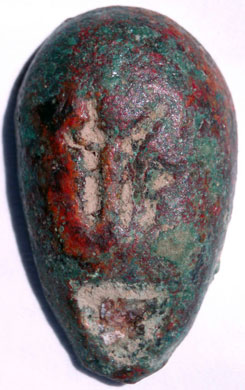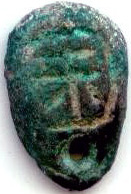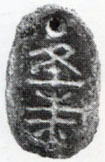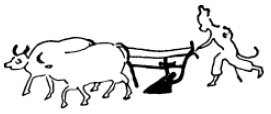 Metal
Metal
Cowrie imitation coins of the Chu state
Images
Jeffrey Young's collection of Chu Bei Gear Fishers collection
Characters on Chu cowrie imitations:
1. Jin
![]()
![]()
 Metal
Metal
2. Jun
![]()
![]()
 Noble
person
Noble
person
3. Xing
![]()
![]()
 Street, road or to go
Street, road or to go
4.
![]()
![]()
 Meaning
and sound uncertain. The left part is shi
Meaning
and sound uncertain. The left part is shi
![]() ten, the right jin
ten, the right jin
![]() axe which were also a weight unit.
Dictionary of Oracle Bone Inscriptions.
axe which were also a weight unit.
Dictionary of Oracle Bone Inscriptions.
![]() is also used on Dang Jin spade coins from this period that were mostly
found in the Chu area (Hartill 3.468-3.473). These spade coins were according to
their legend equivalent to ten
is also used on Dang Jin spade coins from this period that were mostly
found in the Chu area (Hartill 3.468-3.473). These spade coins were according to
their legend equivalent to ten
![]() jin.
Their weight were around 30 grams, roughly the same as ten totem face coins. The
jin weight unit became lighter over time (see weights and units) 275
grams in Qin, 250 grams in Western Han and 235 grams in the Han. It was probably
heavier in the period of the Warring States, XXXTjek herXXX but there was no
standard for all states like in the Qin and Han. My own specimen of a Chu
Dang Jin spade coin weighs 35 grams. If Dang Jin spades weighed
1/10 of a jin, the jin would have been 350 grams, which I think is
possible. The two
jin.
Their weight were around 30 grams, roughly the same as ten totem face coins. The
jin weight unit became lighter over time (see weights and units) 275
grams in Qin, 250 grams in Western Han and 235 grams in the Han. It was probably
heavier in the period of the Warring States, XXXTjek herXXX but there was no
standard for all states like in the Qin and Han. My own specimen of a Chu
Dang Jin spade coin weighs 35 grams. If Dang Jin spades weighed
1/10 of a jin, the jin would have been 350 grams, which I think is
possible. The two
![]() coins in jeffrey Youngs collection weighs XXXX grams. About 1/100 of a jin.
coins in jeffrey Youngs collection weighs XXXX grams. About 1/100 of a jin.
5.
![]()
![]()

 This character is
by Hua Guangpu
This character is
by Hua Guangpu
![]() suggested to be tao
suggested to be tao
![]()
![]() which
is the word for a kiln
Karlgren
1047a. But the character in Hua Guangpu's
catalogue is much closer to Ju
which
is the word for a kiln
Karlgren
1047a. But the character in Hua Guangpu's
catalogue is much closer to Ju
![]()
![]()
![]() . Other
pictures are closer to a character that consists of
. Other
pictures are closer to a character that consists of
![]() he
(standing grain) inside
he
(standing grain) inside
![]() like this
like this
![]()
![]() . But I haven't been able to find this character, even in the
Jiaguwen Zidian or Kang Xi Zidian.
The inner part of the character ju
. But I haven't been able to find this character, even in the
Jiaguwen Zidian or Kang Xi Zidian.
The inner part of the character ju ![]() is rice,
the whole character means a handful
Karlgren 1017a.
Because of this we know that the outer part can mean a curved hand.
I think it may be possible that
is rice,
the whole character means a handful
Karlgren 1017a.
Because of this we know that the outer part can mean a curved hand.
I think it may be possible that
![]() meant a handful of
grain, maybe even as a fixed measure? It is unclear to
me if
meant a handful of
grain, maybe even as a fixed measure? It is unclear to
me if ![]() and
and
![]() are
variants of the same or are two different characters. I will just have to
conclude that the meaning of the
character on this coin is uncertain for now.
are
variants of the same or are two different characters. I will just have to
conclude that the meaning of the
character on this coin is uncertain for now.
6.
![]()
![]()
![]()
 This type has three characters:
sui
This type has three characters:
sui
![]() - tu
- tu ![]() - lei
- lei ![]() . There have been many suggestions to
their meaning; the most commonly used is from Peng Xinwei p. 67: Ge Liu Zhu
. There have been many suggestions to
their meaning; the most commonly used is from Peng Xinwei p. 67: Ge Liu Zhu
![]() which means "Each Six Zhu", but the characters have very little resemblance.
which means "Each Six Zhu", but the characters have very little resemblance.
![]() sui. If you
look in dictionaries for the characters as they appear on the coin, the first is
difficult to find, and you must look in special dictionaries for ancient words, although it is
also part of almost one hundred modern characters:
sui. If you
look in dictionaries for the characters as they appear on the coin, the first is
difficult to find, and you must look in special dictionaries for ancient words, although it is
also part of almost one hundred modern characters: ![]() sui.
Dictionary of Oracle Bones
Inscriptions According to both Karlgren and Jiaguwen Zidian, sui means
to walk like you are pulling something or are dragging your feet along.
This character belongs to the most ancient, and there are very few
sources available. The meaning of this character is clearly derived
from a more basic meaning. For now, I
think it is fair to say that in relation to a plough, it could mean to
pull a plough. My next step will be to try to find more sources from
oracle bones, because I think the derived meaning we got so far
indicates that the original meaning could be to plough.
sui.
Dictionary of Oracle Bones
Inscriptions According to both Karlgren and Jiaguwen Zidian, sui means
to walk like you are pulling something or are dragging your feet along.
This character belongs to the most ancient, and there are very few
sources available. The meaning of this character is clearly derived
from a more basic meaning. For now, I
think it is fair to say that in relation to a plough, it could mean to
pull a plough. My next step will be to try to find more sources from
oracle bones, because I think the derived meaning we got so far
indicates that the original meaning could be to plough.
![]() Tu.
The second character is
clearly
tu
Tu.
The second character is
clearly
tu
![]() which means soil.
which means soil.
![]() Lei. The third character is also very obvious: lei
Lei. The third character is also very obvious: lei
![]() a plough or to plough
Dictionary of Oracle Bones
Inscriptions, and like tu also used in nearly the same form
today.
a plough or to plough
Dictionary of Oracle Bones
Inscriptions, and like tu also used in nearly the same form
today.
Sui is uncertain, but until I have more documentation, I will take the
assumption that the meaning is
![]()
![]() [
[![]() ]
]![]() "The plough that ploughs the soil".
"The plough that ploughs the soil".

A plough scene from the Han period, but most likely the same kind of plough was used in Chu.
7.
 In Jeffrey
Young's
collection,
on Gear Fishers homepage
In Jeffrey
Young's
collection,
on Gear Fishers homepage
 and on Bob Reis' homepage
and on Bob Reis' homepage
 there are
pictures of a
coin with a character that is very close to
there are
pictures of a
coin with a character that is very close to
![]()
![]() yong
which means
"eternal". If you have
pictures of a similar coin (or any other unknown type for that matter) please let me know.
yong
which means
"eternal". If you have
pictures of a similar coin (or any other unknown type for that matter) please let me know.
Kang Xi Zidian is from1715, Karlgren from 1957 and Dictionary of Oracle Bones from 1958. I believe these are some of the best dictionaries for this period. Most bronzes have been found and investigated many years ago, but the main body of the many thousands of inscriptions on ox-shoulder blades, called oracle bones, are a huge source of ancient characters. I think this is the only place to find the remaining characters, also for other types of early coin legends.
Please remember that legends 4-7 are only speculations. I will hopefully find more sources in oracle bone- or
bronze inscriptions that will give more certain answers to the remaining
questions.
Literature:
Xu Zhongshu ed.: Jiaguwen Zidian (Dictionary of Oracle Bone Inscriptions).
Chengdu: Sichuan Cishu, 1988.
Karlgren, Bernhard: Grammatica Serica Recensa. The Museum of Far Eastern
Antiquities, Bulletin No. 29, Stockholm, 1957.
Peng, Xinwei: A Monetary History of
China. Western Washington University, 1994.
Wagner, Donald B.: Iron and Steel in Ancient China. E.J. Brill,
Netherlands,1993.
Hua, Guangpu: Zhongguo Guqian Daji. Hunan Renmin Chubanshe, 2004.
Kang Xi Zidian. China 1715. (Printed in Shanghai 1996).